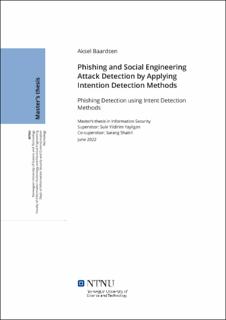| dc.contributor.advisor | Yayilgan, Sule Yildirim | |
| dc.contributor.advisor | Shaikh, Sarang | |
| dc.contributor.author | Baardsen, Aksel | |
| dc.date.accessioned | 2022-07-19T17:21:39Z | |
| dc.date.available | 2022-07-19T17:21:39Z | |
| dc.date.issued | 2022 | |
| dc.identifier | no.ntnu:inspera:106263136:26365637 | |
| dc.identifier.uri | https://hdl.handle.net/11250/3006994 | |
| dc.description.abstract | Nå til dags brukes e-post og SMS daglig av nesten alle i verden. En trussel som følger denne trenden er phishing. Phishing og manipulasjonsangrep er blant de vanligste formene for nettangrep som oppleves nå til dags, siden de ikke er vanskelige for en angriper å utføre. I denne oppgaven angriper vi phishing-problemet ved å bruke modeller samlet fra intensjonsdeteksjons-domenet. Intensjonsdeteksjon er en undersjanger av naturlig språkbehandling, og er svært viktig i datasystemer som dreier seg om menneskelig interaksjon. Intensjonsdeteksjon er allerede tilstede i chat-roboter, nettverksinntrenging, e-handel og mer. Konkret tester vi tre moderne intensjonsdeteksjonsmodeller mot et datasett som består av både phishing og godartede e-poster. Ved å analysere teksten i e-poster med disse modellene klarer vi å identifisere de aller fleste ondsinnede e-poster; modellene for intensjonsdeteksjon gjorde det like bra som de nåværende toppmodellene innen phishing-deteksjon av e-poster. Gjennom eksperimentene i denne oppgaven ble det også oppdaget at det å ikke analysere nettlenker i phishing e-poster ikke forværret klassifikasjonskvaliteten til modellene. | |
| dc.description.abstract | Nowadays, email and SMS are used daily by almost everyone in the developed part of the world. A threat which follows this trend is phishing. Phishing and social engineering attacks are among the most common form of cyberattacks experienced, as they are not complex for an attacker to put together. In this thesis we attack the phishing problem using models gathered from the domain of intention detection. Intent detection is a sub-genre of natural language processing, and is very important in computer systems revolving around human interaction. Applications of intent detection are present in chat-bots, network intrusion, e-commerce, and more. Concretely, we test three of the state of the art intention detection models against a dataset consisting of both phishing and benign emails. By analyzing the text in emails using these models we correctly identify the vast majority of malicious emails; the intention detection models performed as well as the current state of the art in email phishing detection. Through the experiments in this thesis it was also found that not analyzing phishing emails using these models did not degrade the classification quality of the models. | |
| dc.language | eng | |
| dc.publisher | NTNU | |
| dc.title | Phishing and Social Engineering Attack Detection by Applying Intention Detection Methods | |
| dc.type | Master thesis | |
